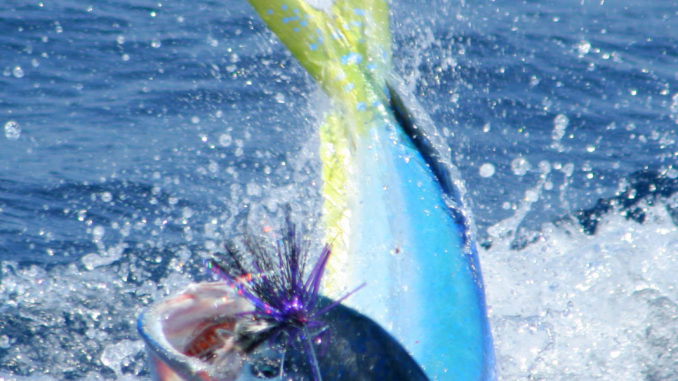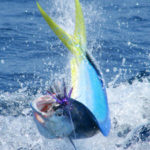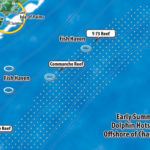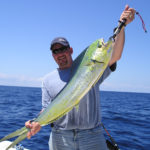
Look for weed lines, floating debris, temperature breaks when targeting June dolphin
For anglers around South Carolina, summer fishing breaks out this month in inshore, nearshore and offshore waters, and for the angler with a taste for grilled dolphin filets, it’s prime time to find a school of these pelagic pleasures not far from the Charleston skyline.
Out of all of the fish roaming the open ocean, dolphin are among the most popular for several reasons. For starters, they are highly regarded for their delectable taste, which is reflected at their price at the seafood market. And since they are among the fastest-growing fish on the planet, they don’t have time to be persnickety when a potential meal comes around. After hooked, anglers can expect an epic battle, especially on light tackle, as dolphin have been documented to take off at speeds exceeding 50 miles per hour.
And most fortunately, anglers don’t need to claim title to a 63-foot sportfisher to get to these fish in June. On a calm day, fishermen in smaller vessels can reach dolphin relatively close to the beach.
Capt. David Yates of Yates and Sea Charters out of Charleston catches his fair share of dolphin a short ride from the harbor.
“They come in closer in June, following in the weed lines,” said Yates. “We catch them consistently from 35 to 50 miles out, but they will also show up as close as 20 miles in 90 feet of water.”
Dolphin typically stay close to the edge or along the inside of the Gulf Stream most of the year, but in June, the Stream often moves closer in, bringing mobs of bait and large schools of hungry predator fishes towards shore.
According to Yates, dolphin arrive off South Carolina on their annual migration from Florida to North Carolina, feeding all the way to fuel their high metabolism.
“Dolphin will travel in pods looking for a good food source, and they are always on the move,” says Yates. “If you ever see any flying fish, there will be a school of dolphin close by.”
Dolphin can’t get enough flying fish in their diets, but sometimes, the airborne species can avoid dolphin, causing the colorful predator to find some other way to calm their hunger pangs. Luckily, Sargasso weed lines are abundant in June, and they’ll fill dolphins’ needs.
The Sargasso weed beds harbor a large congregation of smaller fish, and dolphin are always associated with these weed lines. It would be rare to find a conglomeration of Sargasso weeds this month that doesn’t have a school of dolphin around, picking off small baitfish.
Capt. Rich Harris of The Reel Deal Fishing Charters loves to find a good weed line when targeting dolphin.
“If you stop and look inside the weed line, there are lots of fingerling-sized fish inside the grass of all different kinds,” said Harris. “The thicker the mat, the better it is to find dolphin.”
But if he can’t find weed lines, Harris resorts to searching for areas where baitfish are concentrated using traditional offshore tactics.
“Look for temperature breaks or current rips,” Harris said. “The temperature change in June can be as much as three to four degrees. Also, look for birds.”
Birds of any kind at sea are perfect indicators of feeding activity, and anglers in smaller crafts can have an advantage over the larger boats when a flock of birds is spotted over a school of fish.
“Small boats can easily pick up and run to a school of fish at a distance very quickly,” Harris said. “Always be aware of your surroundings. You never know when a school (of dolphin) might surface out one side of the boat.”
Most of the time, anglers will have several chances to put a dolphin in the boat when a school surfaces. While they do travel in schools, there are certain instances where some dolphin will avoid others of their same species, according to Yates.
“Smaller schoolies will travel together. They travel in similar age-groups born at the same time, but the smaller ones will avoid the bigger adults,” he said. “Since the big bulls are so mean, they will eat the smaller ones without thinking twice about it.”
For fishermen in smaller vessels, most of the big bulls will stay much farther offshore, leaving the shallower grounds to the younger age classes. And since they grow rapidly, feeding is a constant activity that leaves little room for persnickety behavior.
“Dolphin will eat just about anything you put out there,” Yates said. “Put something in front of them and they will eat it.”
Yates uses rigged ballyhoo mostly, but just about any baitfish or squid imitation will con these fish into striking.
Harris will use a trolling spread of five rods on his smaller boats on nearshore trips, nothing as extravagant as his set-ups for tuna and wahoo. He utilizes his outriggers to place a pair of baits back about 150 feet, one in the prop wash and a pair halfway back running off each corner of the boat. He always keeps his baits running close to the surface because that’s where dolphin do most of their feeding. However, he will sometimes run a couple of shallow downriggers pulling dredges or diving plugs to give his spread some depth.
“You are trying to present a large school of baitfish to the dolphin,” he said. “Sometimes, they will swim up around the boat to investigate. The boat puts off a signature just like a weed line. Be ready to throw something at them.”
Harris keeps two pitch baits rigged on a circle hook and ready to feed any dolphin that swim up to the boat. While he prefers to use live bait, he will use whole or dead chunks of fish or squid if that’s all that’s available. Harris recommends anglers to always size the hook to the size of the bait.
“Don’t be a lazy fisherman. Bring a variety of different hooks to match the size of bait you are using,” he said.
DESTINATION INFORMATION
HOW TO GET THERE — Charleston is easily accessed using I-26 or US 17. Boat ramps that offer good access to the ocean through Charleston Harbor are at Shem Creek in Mount Pleasant and the Charleston City Marina off the James Island Expressway. Late in the spring and early in the summer, dolphin can be in water as shallow as 90 feet all the way to the edge of the Gulf Stream. Fishermen in smaller vessels can start trolling as close as the Commanche Reef, looking for weed lines, current rips and flocks of diving birds.
WHEN TO GO — Dolphin begin to slide closer to shore in shallower waters between late May and early June. Anglers can expect to catch dolphin in these waters for the rest of June and even the first few weeks of July if the water doesn’t heat up too fast.
TACKLE/TECHNIQUES — Trolling spreads should include teasers, rigged ballyhoo fished naked or with a colorful skirt (green/yellow, green/white, chartreuse, pink), surface chuggers and diving plugs. Braided line in the 40- to 60-pound range should be on the trolling reel, with a 3- to 12-foot section of 40- to 80-pound mono or fluorocarbon leader. For smaller, schooling-sized fish, 5000 series spinning reels and medium-heavy rods should be sufficient. Hooks should be 3/0 to 7/0 in J or circle hook configurations.
GUIDES/FISHING INFO — Capt. David Yates, Yates & Sea Fishing Charters, 843-568-2521, www.charlestonfunfishing.com; Capt. Rich Harris, The Reel Deal Fishing Charters, 843-388-5093, www.therealdealcharters.com; Haddrell’s Point Tackle, Mount Pleasant, 843-881-3644; Charleston Angler, Mount Pleasant, 843-884-2095; Atlantic Game & Tackle, Mount Pleasant, 843-881-6900. See also Guides and Charters in Classifieds.
ACCOMMODATIONS — Charleston Area Convention & Visitors Bureau, www.charlestoncvb.com.
MAPS — Capt. Segull’s Nautical Charts, 888-473-4855, www.captainsegullcharts.com; Sealake Fishing; Guides, 800-411-0185, www.thegoodspots.com; Maps Unique, 910-458-9923, www.mapsunique.com.







